Laksa Lemak is a rich seafood noodle soup composed of shrimp, puffy tofu, quail eggs, and fish cake, garnished with beansprouts and chives. Optional ingredients include cockles and mussels.
Laksa is the quintessential fusion food from Southeast Asia. My first exposure to this dish was at the Island Café of Tangs on Scotts Road in Singapore. After a morning spent shopping, we ended up at the Island Café. My husband highly recommended this dish to me. While reviewing the menu, I was a little confused about what “fish cake” was and whether this was of Indian, Chinese, Malay origin? Curious, I ordered this dish. Admittedly, I was unprepared for what was served and was pleasantly surprised by the rich complexity of flavors.
Variations of laksa are served from Thailand to Indonesia and the flavors reflect the composition of local ingredients. Depending on whom you ask, the etymology of the word ‘laksa’ could be a derivative of the Sanskrit phrase ‘Lakshaa’ meaning hundreds of thousands (as a nod to the explosion of flavors), from the Cantonese “lɐ̀t sá”, spicy sand referencing the gritty texture used by the ground dried prawns, or even from the Persian word referring to noodles.
What makes laksa unique is that throughout Malaysia and Singapore every state has its own version. But generally speaking, laksa lemak is essentially a seafood broth cooked in, you guessed it, coconut milk (see the distinction between lemak and lodeh). Some people get offended when their chicken curry noodle soup is called a “laksa” simply because the sauce can look similar with coconut milk. Virtually every curry-based sauce served in Malaysia and Singapore has coconut milk.
Two basic varieties of laksa:
- Curry laksa – this focuses on the use of turmeric and coconut milk which is the base of the typical yellow/orange color. The recipe below is based on this construct.
- Assam laksa – this is based on the use of tamarind. Assam is the Malay word for tamarind (and not to be confused with the state of Assam in India)
Ingredients for Laksa Lemak:
Fish Cake: I had heard about fish cakes and balls but struggled to get my head around how they were made and why everyone was raving about it! If you Google fish cake, you’ll find that fish cake is available in many forms from Western Europe, through Africa, and into the Far East. Although their flavor profiles are very different, they all have a common theme. They are essentially fish paste mixed with herbs and spices that have been steamed or fried.
Galangal: Galangal is a branch of the ginger family. Colloquially, it is referred to by various regional names including lengkuas (Malay), or kha (Thai), Sankyo (Japanese), or hong dou Kou (Mandarin), or more commonly as Thai or blue ginger. While traditional Southeast Asian cooking distinguished galangal from its more popular “ginger”, you can use them interchangeably in small quantities. The flavor difference is that galangal has a sharp sweeter, more citrusy tinge whereas ginger is spicier and more pungent.
Bean curd: Bean curd or tofu is made from soybeans that have been ground and pressed. A staple of the Far East and Southeast Asian cooking for over two millennia, soybeans are high in protein and low in saturated fats. While tofu comes in many forms, fried tofu (either in puff or skin formats) is commonly used in making broth-based dishes.
Noodles: The traditional noodle for laksa is the udon-type noodle. Udon is a wheat-based noodle that is a mild, pale, thick, rounded noodle. These characteristics allow the noodle to ‘hold together well and act as a contrast tempering the spicy laksa broth. That said, there are variations of laksa that are commercially available that use rice vermicelli or ramen. The key element is to cook these noodles al dente to ensure that they are not overcooked when served with the hot broth.
Dried shrimp: Dried shrimp are shrimp that have been sun-dried. This dehydrating not only concentrates the flavor but allows for longer preservation. A staple of Asian cooking, dried shrimp add a ‘sea-foody’ flavor to any dish. As the shrimp are dehydrated, you should rehydrate them and in some instances, grind and fry them to unlock the flavors.
Candlenuts: The candlenut is native to South East Asia and Australia and has also migrated to the Polynesian cultures. It is known as the kukui nut in Hawaii and is also the state tree. It is also known as the Indian walnut; ‘Buah Keras in Malay, ‘kemiri in Indonesia; and ‘plumbing’ in the Philippines. Fresh nuts can be toxic, so they must be roasted or cooked to lose their toxicity. Roasting the slivers releases the nutty flavors and acts as a thickening agent to the broth. If you can’t get candlenuts for the laksa, you can substitute it with roasted Brazil nuts or even macadamia nuts (as I have done here). The flavor profile will subtly change from the traditional flavors, but the primary purpose of the candlenut is to thicken the broth while adding a nutty flavor.
Lemongrass: Lemongrass is a common grass all over Southeast Asia and is used typically to add a fresh revitalizing flavor to the dish. Historically, when combined with ginger, this herb is made into a broth that provides both nourishment against chills or fever and also is said to relieve stress and anxiety.
Laksa leaf: The laksa leaf has a distinct lemon–cilantro flavor and is common in Southeast Asian cooking. It is commonly known as ‘daun resume in Malay or even as Vietnamese cilantro. While it is added as a garnish, its addition as an aromatic is incredible. That said, it is fairly difficult to find this, so you can substitute it with kaffir lime leaves. Bear in mind, the laksa leaf is finely chopped and added as a garnish to provide an instant uplift to the broth. Now if you are worried that this dish has too much acid because of using both lemongrass and laksa, don’t be. There’s a proportion that is observed.
Over the years, many have told me that laksa lemak was not an easy dish to master. In truth, a well-made bowl of laksa can be quite tricky to make, primarily because the delicacy of the broth makes the proportions and balance very important. Food, along with soccer (the locals call it football), is a way of life and the locals are incredibly fervent and very opinionated when it comes to both their local dishes and their sport. My husband, who is a 3rd generation Straits-born Indian, can be vociferous in judging his native dishes. So, it is with a sense of accomplishment (many years ago), after seeing him smile contentedly every time I make it, that I am sharing this recipe.
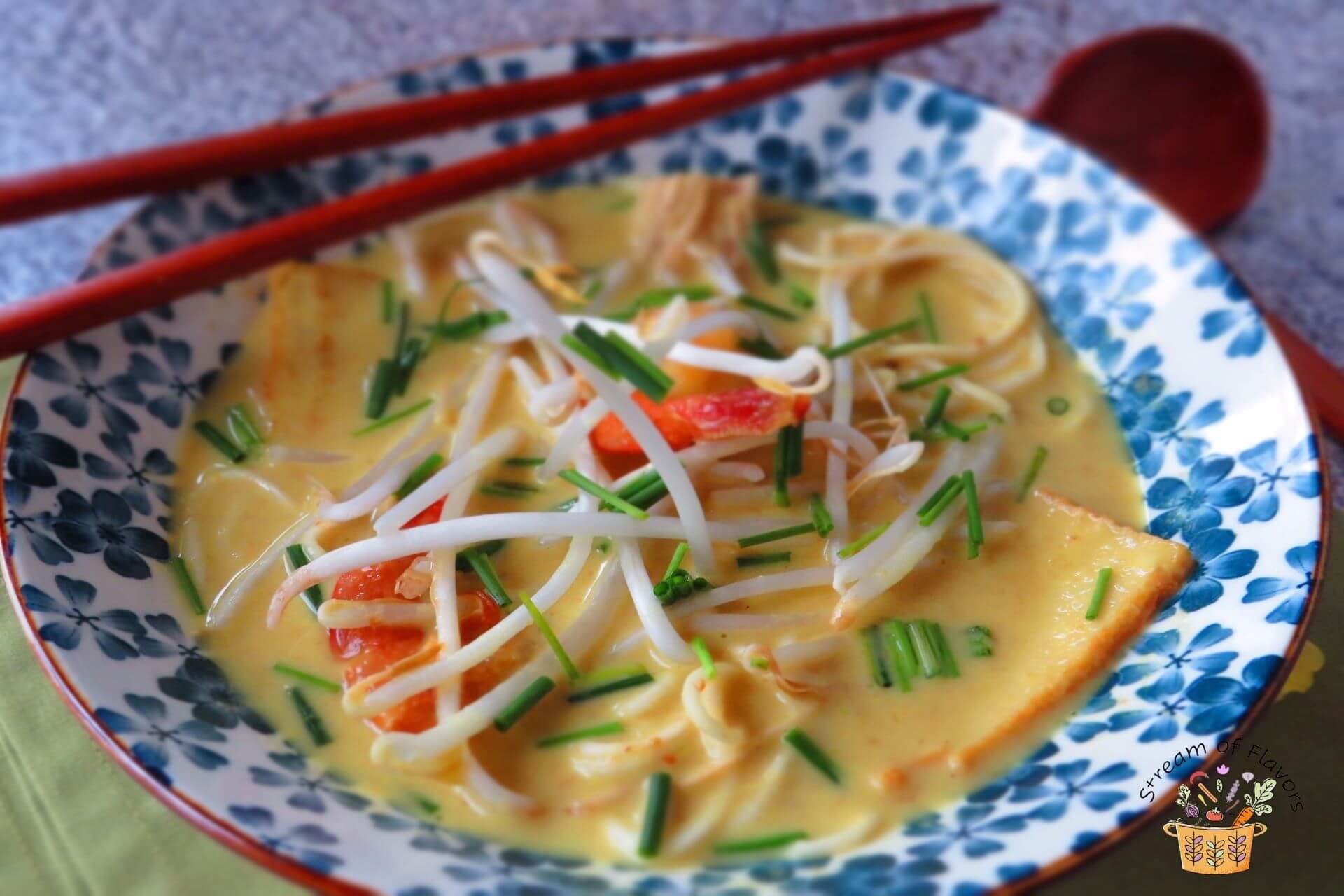
Substitutions:
- Use fresh or dried ginger if you cannot find galangal.
- Dried turmeric powder works well if you do not have access to fresh turmeric sticks.
- Macadamia nuts are a good substitution for candlenuts that are not usually available here.
- Fish cake is an essential add-on but you could do without it and still not alter the taste of the laksa.
- Firm tofu can be used instead of puffy tofu, but take care while mixing the tofu so as not to break them. If you like to use dried bean curd sticks, then soak them in hot water for 3 minutes before adding them to the broth.
- Canned coconut milk tastes fine if you want to make the laksa in a jiffy.
How to make Laksa Lemak:
- How to make the spice paste:
- How to make the laksa lemak:
- How to make the spice paste:
- Grind all the ingredients for the spice paste in a blender with a little water to make a fine paste.
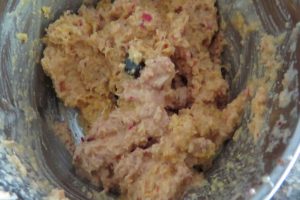
2. How to make the laksa lemak:
- Heat a wok with 2 tablespoons of peanut oil. Add the spice paste and sauté until slightly brown and fragrant for 3 minutes. Keep scraping the bottom of the wok.
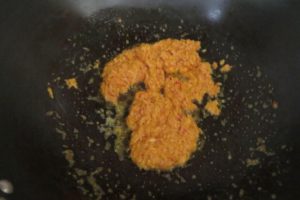
- Add the cleaned shrimp and sauté with the paste for 3 minutes.
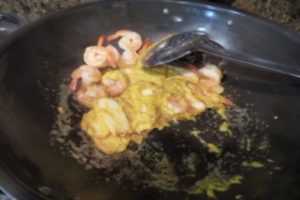
- Toss in the fish cake and puffy tofu and sauté for 2 minutes.
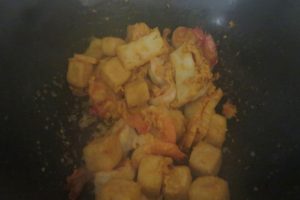
- Add the water and cook for 3 minutes.
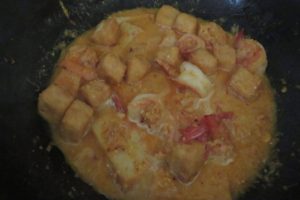
- Prepare fresh coconut milk by pulsing grated coconut with water.
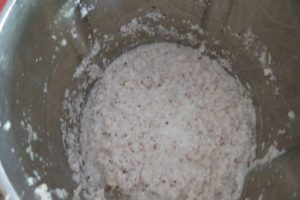
- Strain the coconut milk by squeezing out the pulp. Discard the residue and use the milk for the laksa.
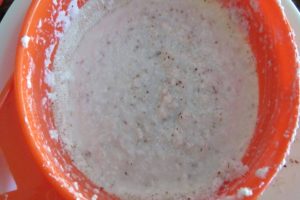
- Add the coconut milk and simmer for a minute.
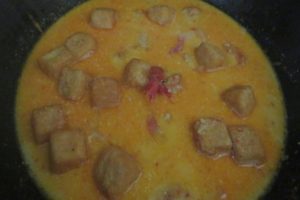
- Add the bean sprouts, turn off the heat.
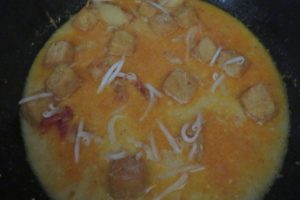
- Garnish with scallions, or chives, kaffir lime leaves, and boiled eggs(optional).
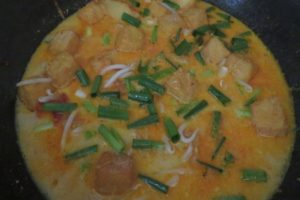
- Follow instructions on cooking thick noodles (white or yellow). Drain the (al dente) noodles and serve the laksa lemak with some noodles in a noodle bowl.
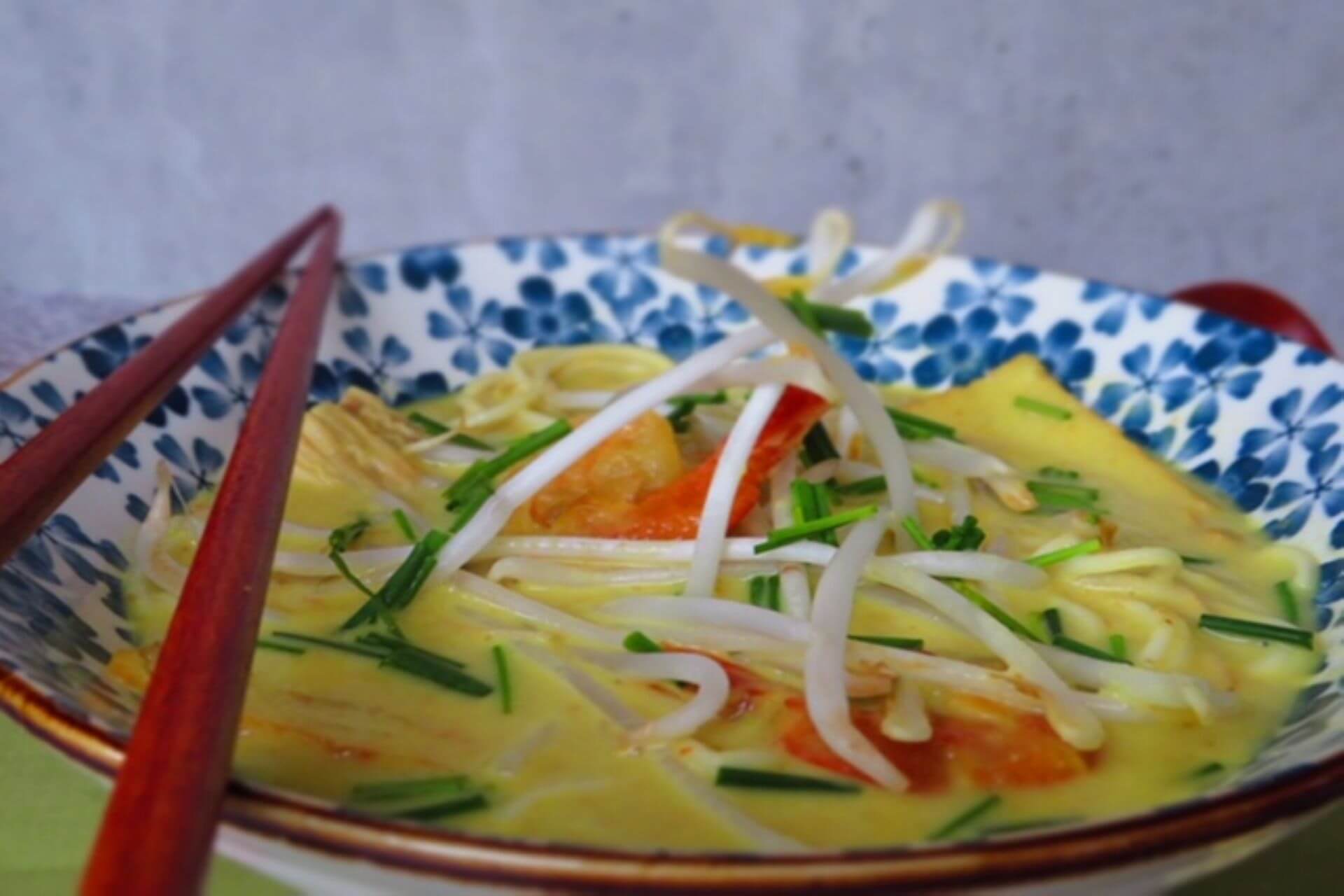
1. Sauté the spice paste until fragrant. Do not hasten this step as what you should be going for is an aromatic spice paste that will enhance the flavor of the broth.
2. Fry the fish cake or other add-ons before adding water.
3. Cook the noodles to al dente or the noodles will get mushy when added with the broth.
How to serve:
- In a pasta bowl or preferably laksa bowl, scoop some noodles. Pour the broth with the shrimp, bean curd and fish cake. Garnish with bean sprouts and chives or scallions. Serve hot.
- Serve it with Singapore Popiah for an appetizer and Bubur Chacha for dessert!
How to store:
Laksa Lemak is a seafood noodle soup that will evoke the essence of the sea. It is usually best when consumed the day of making it. But you can freeze leftovers in a freezer box, although it is not recommended.
Laksa Lemak
Equipment
- Wok (stovetop)
Ingredients
For the spice paste:
- 2 tbsp macadamia unsalted, roasted
- ½ cup shallot chopped
- 2 dried red chili deseeded
- 2 Thai chili
- 2 tbsp dried shrimp
- 1 tbsp galangal peeled, chopped
- 3 lemongrass white part only
- ½ tsp fresh turmeric peeled, chopped
- 1 tbsp peanut oil
- 2 tsp salt
For the laksa lemak:
- ½ lb jumbo shrimp de-veined, tail on
- ½ pack fish cake thinly sliced
- 12 fried puffy tofu
- 3 cups coconut milk from 1 coconut
- 2 cup filtered water
- 1½ tbsp peanut oil
- 1 pack beansprouts
- a few chives chopped
- 1 pack round yellow or white noodles follow instructions for cooking
- 4 boiled eggs optional
Instructions
How to make the spice paste:
- Grind all the ingredients for the spice paste in a food processor with a little water to make a fine paste.
How to make the laksa lemak:
- Heat a wok and add the peanut oil. Add the spice paste and sauté until slightly brown and fragrant for 3 minutes. Keep scraping the bottom of the wok.
- Add the cleaned shrimp and sauté with the paste for 3 minutes.
- Toss in the fish cake and fried puffy tofu and sauté for 2 minutes.
- Add the water and cook for 3 minutes.
- Prepare fresh coconut milk by pulsing grated coconut with water.
- Strain the coconut milk by squeezing out the pulp. Discard the residue and use the milk for the laksa.
- Add the coconut milk and simmer for a minute.
- Add the bean sprouts, turn off the heat.
- Garnish with chives and/or boiled eggs. Optionally, you use scallion, kaffir lime leaves for garnish.
- Follow instructions on cooking thick noodles (white or yellow). Drain the (al dente) noodles and serve the laksa lemak with some noodles in a noodle bowl.
Notes
- Optional ingredients to add are cockles and mussels. Cooked quail eggs are also used.
- The authentic flavor of the laksa is from the spice paste. This recipe is balanced and proportional. Adjust the quantity based on the amount of noodle soup you are making. Store-bought laksa paste has never tasted as good as the from-scratch homemade paste.
- Garnish with kaffir lime leaves if you can find them.
Nutrition


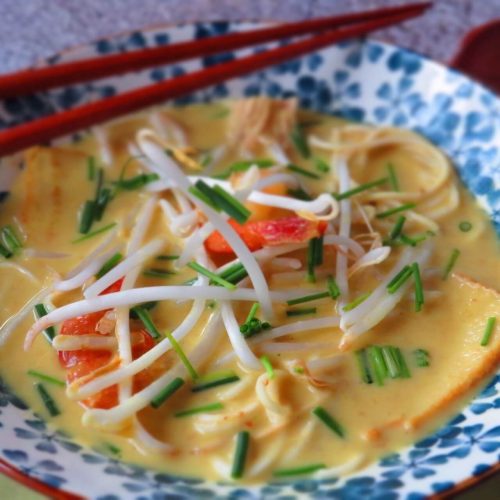
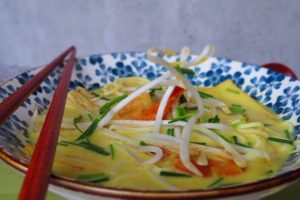





















I love Laksa! Thanks for posting this recipe, now I am able to make it myself!
Danya, you are welcome! Good to hear that you tried it.
Thanks for showing how to make laksa!
You’re welcome, Kate!
A wonderful blend of flavours!
This is absolutely delicious! Well worth the time spent!